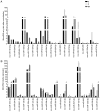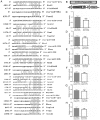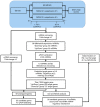Biliverdin administration regulates the microRNA-mRNA expressional network associated with neuroprotection in cerebral ischemia reperfusion injury in rats
- PMID: 30664169
- PMCID: PMC6365090
- DOI: 10.3892/ijmm.2019.4064
Biliverdin administration regulates the microRNA-mRNA expressional network associated with neuroprotection in cerebral ischemia reperfusion injury in rats
Abstract
Inflammatory response has an important role in the outcome of cerebral ischemia reperfusion injury (CIR). Biliverdin (BV) administration can relieve CIR in rats, but the mechanism remains unknown. The aim of the present study was to explore the expressional network of microRNA (miRNA)‑mRNA in CIR rats following BV administration. A rat middle cerebral artery occlusion model with BV treatment was established. After neurobehavior was evaluated by neurological severity scores (NSS), miRNA and mRNA expressional profiles were analyzed by microarray technology from the cerebral cortex subjected to ischemia and BV administration. Then, bioinformatics prediction was used to screen the correlation between miRNA and mRNA, and 20 candidate miRNAs and 33 candidate mRNAs were verified by reverse transcription‑quantitative polymerase chain reaction. Furthermore, the regulation relationship between ETS proto‑oncogene 1 (Ets1) and miRNA204‑5p was examined by luciferase assay. A total of 86 miRNAs were differentially expressed in the BV group compared with the other groups. A total of 10 miRNAs and 26 candidate genes were identified as a core 'microRNA‑mRNA' regulatory network that was linked with the functional improvement of BV administration in CIR rats. Lastly, the luciferase assay results confirmed that miRNA204‑5p directly targeted Ets1. The present findings suggest that BV administration may regulate multiple miRNAs and mRNAs to improve neurobehavior in CIR rats, by influencing cell proliferation, apoptosis, maintaining ATP homeostasis, and angiogenesis.
Figures









Similar articles
-
Identification and functional analysis of microRNAs in rats following focal cerebral ischemia injury.Mol Med Rep. 2019 May;19(5):4175-4184. doi: 10.3892/mmr.2019.10073. Epub 2019 Mar 21. Mol Med Rep. 2019. PMID: 30896823 Free PMC article.
-
Differentially expressed genes induced by β-caryophyllene in a rat model of cerebral ischemia-reperfusion injury.Life Sci. 2021 May 15;273:119293. doi: 10.1016/j.lfs.2021.119293. Epub 2021 Mar 8. Life Sci. 2021. PMID: 33705733
-
Biliverdin modulates the long non-coding RNA H19/microRNA-181b-5p/endothelial cell specific molecule 1 axis to alleviate cerebral ischemia reperfusion injury.Biomed Pharmacother. 2022 Sep;153:113455. doi: 10.1016/j.biopha.2022.113455. Epub 2022 Jul 22. Biomed Pharmacother. 2022. PMID: 36076490
-
Neuroprotective Effects of Peptides in the Brain: Transcriptome Approach.Biochemistry (Mosc). 2020 Mar;85(3):279-287. doi: 10.1134/S0006297920030037. Biochemistry (Mosc). 2020. PMID: 32564732 Review.
-
Causes and Consequences of MicroRNA Dysregulation Following Cerebral Ischemia-Reperfusion Injury.CNS Neurol Disord Drug Targets. 2019;18(3):212-221. doi: 10.2174/1871527318666190204104629. CNS Neurol Disord Drug Targets. 2019. PMID: 30714533 Review.
Cited by
-
Cytoprotective Role of Heme Oxygenase-1 in Cancer Chemoresistance: Focus on Antioxidant, Antiapoptotic, and Pro-Autophagy Properties.Antioxidants (Basel). 2023 Jun 5;12(6):1217. doi: 10.3390/antiox12061217. Antioxidants (Basel). 2023. PMID: 37371947 Free PMC article. Review.
-
Bile pigments in emergency and critical care medicine.Eur J Med Res. 2022 Oct 29;27(1):224. doi: 10.1186/s40001-022-00863-0. Eur J Med Res. 2022. PMID: 36309733 Free PMC article. Review.
-
Heme Oxygenase Dependent Bilirubin Generation in Vascular Cells: A Role in Preventing Endothelial Dysfunction in Local Tissue Microenvironment?Front Physiol. 2020 Jan 29;11:23. doi: 10.3389/fphys.2020.00023. eCollection 2020. Front Physiol. 2020. PMID: 32082188 Free PMC article. Review.
-
Biliverdin Protects Against Cerebral Ischemia/Reperfusion Injury by Regulating the miR-27a-3p/Rgs1 Axis.Neuropsychiatr Dis Treat. 2021 Apr 22;17:1165-1181. doi: 10.2147/NDT.S300773. eCollection 2021. Neuropsychiatr Dis Treat. 2021. PMID: 33911865 Free PMC article.
-
The Role of Bilirubin and the Other "Yellow Players" in Neurodegenerative Diseases.Antioxidants (Basel). 2020 Sep 22;9(9):900. doi: 10.3390/antiox9090900. Antioxidants (Basel). 2020. PMID: 32971784 Free PMC article. Review.
References
MeSH terms
Substances
LinkOut - more resources
Full Text Sources
Miscellaneous

